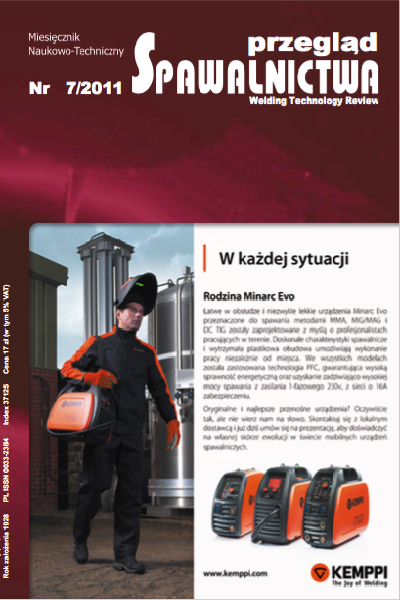Analiza struktury i składu chemicznego połączeń spawanych: płyta trudnościeralna stal konstrukcyjna
Main Article Content
Abstract
W artykule przedstawiono analizę strukturalną i składu chemicznego połączenia spawanego płyty trudnościeralnej ze stalą konstrukcyjną S235JR wykonanego metodą MAG drutem litym G3Si1 o średnicy 1,2 mm w osłonie mieszanki aktywnej Arcal 21 (92% Ar + 8% Co2). Przeprowadzone badania wizualne i penetracyjne, badania metalograficzne :makro- i mikroskopowe oraz mikroanaliza rentgenowska składu chemicznego i rozkładu pierwiastków stopowych w obszarze spoiny pozwoliły na określenie zmian struktury i towarzyszących im zmian składu chemicznego zachodzących w poszczególnych obszarach złącza spawanego. Badania dowiodły, że w wyniku spawania dochodzi do stopienia materiału warstwy odpornej na zużycie ścierne i przejścia węglików do spoiny oraz częściowego niejed- norodnego wymieszania spawanych materiałów, co powoduje wzrost twardości w tym obszarze do 600 HV i może być przyczyną powstania pęknięć od strony lica spoiny. Badania nie wykazały obecności pęknięć w obszarze grani spoiny. Analizując wyniki badań, należy stwierdzić, że wykonane złącze spawane spełnia wymogi eksploatacyjne stawiane połączeniom tego typu.
The structure and chemical comopsition of joint of abrasion-resistating plate and construction steel analysis
Abstract
The article analyzes the structural and chemical composition of the abrasive resistant plates with structural steel S235JR welded joints made by MAG G3Si1 solid wire with a diameter of 1.2 mm in the shielding active gas Arcal 21 (92% Ar + 8% Co2). Visual and penetrant testing, metallographic examination: macro, micro and microsco- pic X-ray analysis of chemical composition and distribution of alloying elements in the weld area allowed us to identify structural changes and accompanying changes in chemical composition occurring in the various areas of the welded joints. Research shown that the abrasive-resistant layer is melted in the welding process. Moreover the carbide transition into the weld and the partial non-homogenous mixing of welded materials, which increases the hardness in this area up to 600 HV and may cause cracks on the face of the weld are obtained. The study does not reveal the cracks in the weld root. Analyzing the results of the study should be noted that the welded joint made meets the requirements of this type of connections.
Downloads
Article Details
Creative Commons CC BY 4.0 https://creativecommons.org/licenses/by/4.0/
Welding Technology Review (WTR) articles are published open access under a CC BY licence (Creative Commons Attribution 4.0 International licence). The CC BY licence is the most open licence available and considered the industry 'gold standard' for open access; it is also preferred by many funders. This licence allows readers to copy and redistribute the material in any medium or format, and to alter, transform, or build upon the material, including for commercial use, providing the original author is credited.
References
Klimpel A., Górka J., Czupryński A.: Comparison of chromium cast iron deposits of wear plates, Journal of Achievements in Materials and Manufacturing Engineering, Vol. 18, Issue 1-2, September-october 2006, s. 387-390.
Klimpel A., Górka J.: Properties of chromium cast iron deposits SSA surfaced, The14th International Scientific Conference on Achievements in Mechanical and Materials Engineering AMME2006, Gliwice-Wisła. 16-18 maja 2006.
Francis J.A.: Prediction of steady state dilution in multipass hardfacing overlays deposited by self shielded FCAW, Science and Technology of Welding, nr 2/02.
Castolin Eutectic, Catalogue, CastoDur Diamond Plates, CastoTubes.
Sapate S.G., Rama Rao A.V.: Effect of carbide fraction on erosive wear behaviour of hardfacing cast irons, Wear, nr 256, 2004.
Stevenson A.N.J., Hutchings I.M.: Wear of hardfacing white cast irons by solid particle erosion, Wear, 186-187, 1995.
Kasuya T., Hashiba Y., ohkita S., Fuji M.: Hydrogen distribution in multipass submerged arc weld metals, Science and Technology of Welding and Joining, nr 4/2001.
